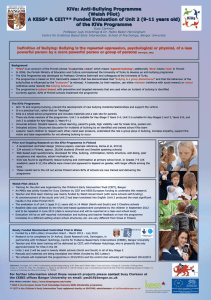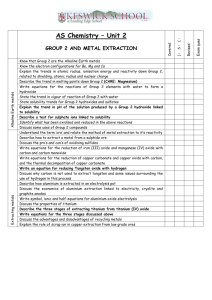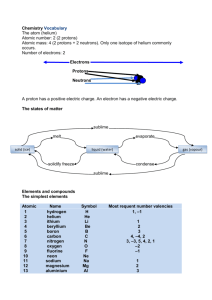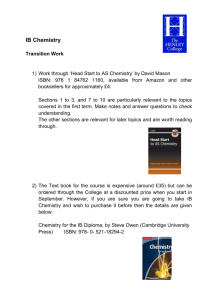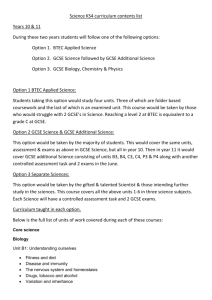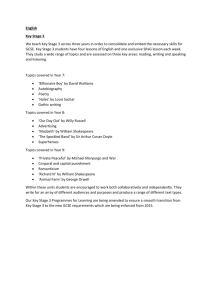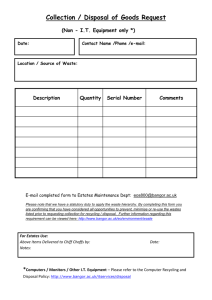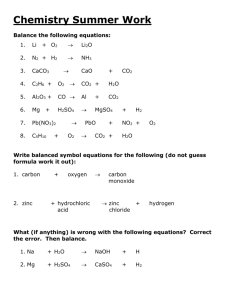Chemistry 1 - Bangor University
advertisement
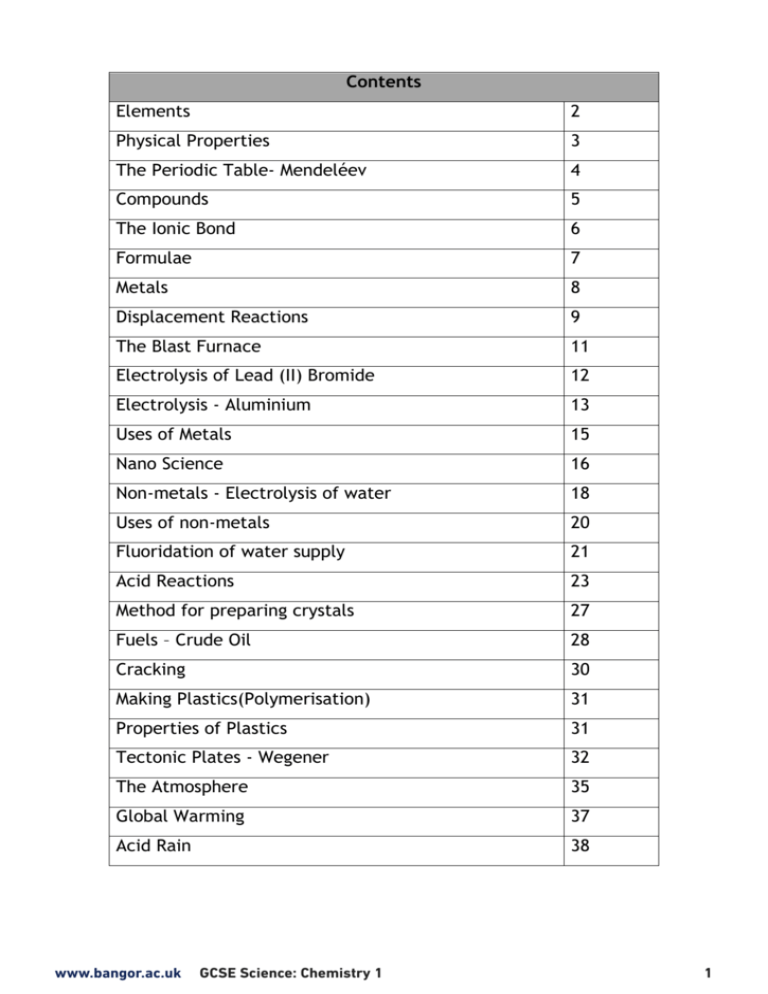
Contents Elements 2 Physical Properties 3 The Periodic Table- Mendeléev 4 Compounds 5 The Ionic Bond 6 Formulae 7 Metals 8 Displacement Reactions 9 The Blast Furnace 11 Electrolysis of Lead (II) Bromide 12 Electrolysis - Aluminium 13 Uses of Metals 15 Nano Science 16 Non-metals - Electrolysis of water 18 Uses of non-metals 20 Fluoridation of water supply 21 Acid Reactions 23 Method for preparing crystals 27 Fuels – Crude Oil 28 Cracking 30 Making Plastics(Polymerisation) 31 Properties of Plastics 31 Tectonic Plates - Wegener 32 The Atmosphere 35 Global Warming 37 Acid Rain 38 www.bangor.ac.uk GCSE Science: Chemistry 1 1 Elements Element + Na + Na + Na Na Na Na Elements are the building blocks of all substances. They cannot be broken down into simpler substances by chemical means + + Na + Na + Na + An Element contains only one type of atom + Atom Each atom has negatively charged electrons orbiting a positively charged nucleus Electron (negative) Nucleus (positive) Shell Proton Protons are positive, neutrons are neutral (no charge). This is why the nucleus has an overall positive charge Neutron The Periodic Table - Basics Group There are eight groups down across Period 1 2 3 4 5 6 7 Describing Position Sodium is in Group 1, Period 3 Helium is in Group 0, Period 1 Beryllium is in Group 2, Period 2 2 GCSE Science: Chemistry 1 www.bangor.ac.uk www.bangor.ac.uk GCSE Science: Chemistry 1 3 Can be hammered into sheets Can be pulled into wires Ductile Metals Malleable High Melting point Boiling point Conduct Heat Conduct Electricity Physical Properties Non Metals Not ductile Not malleable Low Melting point Boiling point Does not conduct heat Does not conduct Electricity Many elements in Group 3, 4, 5 show metallic and non-metallic properties Elements change from being metals to non-metals on going from left to right across the Periodic Table Metals Non-Metals Periodic Table Scientists as far back as 1817 found patterns in the reactivity of elements; however it was Mendeléev (1869) who first arranged the elements in a layout recognisable as a Periodic Table. is due to Mendeléev He placed the elements into 8 groups, in each group elements reacted similarly. Elements were arranged according to 1. Increasing atomic mass (top number) 2. Similar chemical properties Confident in his work he left gaps predicting that some elements that were not discovered at the time should be placed there as they would have similar properties In the old group1 there are different elements such as Copper, Silver and Gold Gaps where he predicted an element with similar properties should exist Group 4 has many elements which are in the transitional group today Group 8 and not Group 0 like today. The periodic table is also arranged by now in increasing atomic number (bottom number) There are many more elements now as scientists have discovered them over the years. These elements have fitted into the gaps left by Mendeléev. 4 GCSE Science: Chemistry 1 www.bangor.ac.uk Compounds Substance that contains two or more elements joined together chemically Number of elements = 2 Formula Hydrogen H2O H H2O H Elements Oxygen Atoms 2 Hydrogen O 1 Oxygen Number of atoms = 3 Compound Formula No. of atoms NaCl No. of elements 2 Sodium Chloride Sodium Hydroxide NaOH 3 3 (1 Na, 1 O, 1 H) Sodium Oxide Na2O 2 3 (2 Na, 1 O) Sodium Sulfate Na2SO4 3 7 (2 Na, 1 S, 4 O) Calcium Carbonate CaCO3 3 5 (1 Ca, 1 C, 3 O) Chemical Reactions 2 (1 Na, 1 Cl) Atoms are rearranged but none are created or destroyed e.g. Mg + 2HCl MgCl2 + H2 Same number of atoms in reactants and products, atoms are differently arranged. www.bangor.ac.uk GCSE Science: Chemistry 1 5 The Ionic Bond Ionic Compounds When a chemical reaction takes place new bonds are formed. Ionic compounds form by the transfer of electrons from metal to non-metal atom. Charged particles called ions are formed e.g. When sodium chloride (NaCl) forms, one electron is transferred from sodium to chlorine. This will form a full stable outer shell (like noble gasses) for the two particles METAL NON-METAL Electron Transfer One electron lost One electron gained POSITIVE ION NEGATIVE ION Ions held together by attraction between their opposite charges 6 GCSE Science: Chemistry 1 www.bangor.ac.uk Using ions to create formulae Lithium = Li+ Sodium = Na+ chloride = ClMagnesium = Mg2+ Potassium = K+ Calcium = Ca2+ Sodium Chloride Na+ Magnesium Oxide Cl- Mg Ions cancel O Sulfate= SO42-- Mg2+ Na+ www.bangor.ac.uk Mg2+ ClCl- Ions cancel Ions cancel Li2O MgCl2 Nitrate = NO3- Lithium Oxide Li+ Mg(OH)2 OH- Calcium Carbonate Ca2 + CO32 -- O2- Li2O Sodium Carbonate Na+ CO32 -- Ions cancel Ions cancel Na2CO3 O2- Ions cancel Sodium Carbonate -- Magnesium Chloride Quick method OH- Two sets of (brackets used) CO32 Lithium Oxide Carbonate = CO32-- OH- Ions cancel Na+ iodide = I- Li+ Magnesium Hydroxide Sodium Hydroxide NaOH sulfide = S2- Li+ 2- MgO Hydroxide= OH- OH- bromide = Br- Ions cancel NaCl Na+ 2+ oxide = O2- CaCO3 GCSE Science: Chemistry 1 Na2CO3 7 Extraction of Metals Ores – Metals are found in compounds in rocks which make up the Earth’s crust, these are called ores Ore Bauxite Formula Al2O3 Metal extracted Aluminium Haematite Fe2O3 Iron Extraction is the term for getting pure metal out of the ore; there are two methods of extracting metals which depend on their reactivity Reduction is the process of removing oxygen from the ore using carbon Electrolysis is the process of using electricity to extract a metal Reactivity Series – metals are placed in order of reactivity by reacting them with oxygen, water and acid. From this data a reactivity series is produced The Reactivity Series Extraction Method Increasing Reactivity Potassium Sodium Metals more reactive than carbon Calcium are extracted using Magnesium ELECTROLYSIS Aluminium (Carbon) Zinc Iron Lead Hydrogen Metals less reactive than carbon are extracted by CHEMICAL REDUCTION using CARBON Copper Silver Unreactive - occur naturally as Gold elements (NATIVE) At the top metals naturally bond to oxygen stronger which makes it difficult to remove. 8 GCSE Science: Chemistry 1 www.bangor.ac.uk Displacement Reactions Reduction is the loss of oxygen from a compound Oxidation is the gain of oxygen to form a compound Magnesium and copper oxide Mg + CuO MgO + Cu oxidation Heat Magnesium + copper oxide magnesium oxide + copper reduction Blast Furnace Reaction Fe2O3 + 3CO Iron oxide and carbon monoxide 3CO2 + 2Fe oxidation iron oxide + carbon carbon monoxide + iron Heat reduction The Thermite Reaction Fe2O3 + 2Al Al2O3 + 2Fe oxidation Iron oxide + aluminium aluminium oxide + iron reduction www.bangor.ac.uk GCSE Science: Chemistry 1 9 Displacement Examples Iron and copper chloride iron + copper chloride Fe + CuCl2 Cu + FeCl2 copper + iron chloride iron is more reactive than copper, as a result iron displaces copper copper and silver nitrate* copper + silver nitrate Cu + 2AgNO3 2Ag + Cu(NO3)2 silver + copper nitrate copper is more reactive than silver, as a result copper displaces silver zinc and copper sulphate* zinc + copper sulfate Zn + CuSO4 Cu + ZnSO4 copper+ zinc sulfate zinc is more reactive than copper, as a result zinc displaces copper * higher tier only 10 GCSE Science: Chemistry 1 www.bangor.ac.uk The Blast Furnace – The extraction of iron There are 4 raw materials; iron ore, coke, limestone and hot air Iron ore – the source of iron Coke – a fuel that produces carbon monoxide for the reduction reaction Limestone – to remove impurities. Limestone breaks down and reacts with sand from the rocks to form slag Hot air – the fourth raw material Required for coke to burn Raw Materials 1. Iron ore 2. Limestone 3. Coke Waste gases 1600˚C 4. Hot air (raw material) slag Molten iron Carbon (coke) and oxygen (from the hot air) produce carbon monoxide and gives off heat. Reduction is achieved by Carbon monoxide at a high temperature Iron oxide + carbon monoxide Fe2O3 + 3 CO iron + carbon dioxide 2 Fe + 3 CO2 Getting the furnace up to temperature takes a lot of time and costs a lot. As a result raw materials are constantly added and products removed – the process is continuous. At the factory in Port Talbot iron ore, limestone and coke are imported from other countries even though they are available in Wales. Using raw materials from Wales is not sustainable due to cost and the effect it could have on the environment (quarrying). www.bangor.ac.uk GCSE Science: Chemistry 1 11 Electrolysis of Lead (II) Bromide At the negative electrode / cathode Pb2+ + 2e Pb At the positive electrode / anode 2Br - 2e Br2 The positive ions Pb2+ move towards the cathode where they gain electrons The negative ions Br move towards the anode where they lose electrons 12 GCSE Science: Chemistry 1 www.bangor.ac.uk Electrolysis of Aluminium Oxide Electrolysis is the method used to extract aluminium from aluminium oxide As aluminium is a reactive metal, aluminium oxide is very stable, a more powerful method is needed to break the bonds Al3+ Al 3+ O2- Al3+ 2- O O22- O Al3+ O2- negative electrode O2- Electrolysis is the decomposition of a compound using electricity. Electrodes carry the current into and out of the molten compound, they are conducting rods. One is positive and the other is negative. Positive electrode Anode = positive electrode Cathode = negative electrode Electrolyte Electrolyte is a solution containing ions. **Must be dissolved or molten to allow ions to move and carry charge** Aluminium Extraction (Separating aluminium oxide to create aluminium) Electrolyte = molten aluminium oxide (950˚C) Electrodes = Carbon Both electrodes are placed in molten aluminium oxide (electrolyte). This contains ions of aluminium (+ charge) and oxygen (- charge). These are able to move when molten and therefore allow conduction of electricity. positive electrode anode negative electrode cathode oxygen gas molten aluminium oxide (electrolyte) molten aluminium www.bangor.ac.uk GCSE Science: Chemistry 1 13 Electrolysis of Aluminium Oxide Aluminium ions are attracted to the negative electrode (cathode) Oxygen ions are attracted to the positive electrode (anode) Reaction at the negative electrode cathode Reaction at the positive electrode anode aluminium ions+ electrons aluminium atoms Al3+ + 3e Al Oxide ions – electrons oxygen molecules 2O2- - 4e O2 Aluminium has many uses due to its physical properties Uses Car manufacturing Power lines Saucepans Aeroplanes Property Resistant to corrosion Electrical conductivity Heat conduction Low density Locating aluminium plants Electrolysis is an expensive process as it needs a lot electrical energy constantly. Most are located next to a power station Aluminium is reactive so it needs an enormous amount of electricity to separate it from oxygen. Also it is expensive as it needs heat energy to heat up the ore to 1000˚C The energy costs associated with aluminium production are very high and when Wylfa Power Station was decommissioned, Anglesey Aluminium closed. When it was running the plant accounted for around 10-15% of all the electricity used in Wales. Without a power station close by, guaranteeing the supply of electricity, this became unsustainable and the plant closed. Factories are located near the coast as they need to import the aluminium ore from abroad. To increase the lifetime of metal ores such as aluminium oxide and iron oxide it is necessary to recycle metals. Recycling aluminum uses only about 5% of the energy needed to extract it from bauxite and saves waste. Less electrical consumption means less greenhouse gas (CO2) emissions. The environment is spoilt by quarrying. 14 GCSE Science: Chemistry 1 www.bangor.ac.uk Uses of metals Copper Copper has many uses due to its physical properties Uses Property Jewellery electrical Wires saucepans pipes Electrical wires Shiny Electrical conduction Heat conduction Malleability ( create sheets ) Ductility ( create wires ) Titanium Titanium is important as an alloying agent with aluminum, manganese, iron, and other metals. Alloys of titanium are principally used for aircraft and missiles where lightweight strength and ability to withstand extremes of temperature are important. Titanium is as strong as steel, but 45% lighter. It is 60% heavier than aluminium, but twice as strong. Does not corrode in water. 1660 ºC M.pt molybdenum, An alloy is a mixture made by mixing molten metals; the properties can be changed by altering the amount of each metal Steel Steels are a large family of metals. All of them are alloys in which iron is mixed with carbon and other elements. Steels are described as mild, mediumor high-carbon steels according to the percentage of carbon they contain, although this is never greater than about 1.5%. Type of steel Percentage of carbon Strength Mild steel Up to 0.25% hard Medium carbon steel 0.25% to 0.45% harder High carbon steel 0.45% to 1.50% hardest The metal in the scissors contains nearly twenty times as much carbon and is many times harder than the steel in a drinking can. Steel is recycled on a large scale. Recycling steel saves 50% of the energy used in the extraction of iron. Recycling helps to conserve iron ore Recycling cuts down on the emission of greenhouse gases (carbon dioxide) www.bangor.ac.uk GCSE Science: Chemistry 1 15 Nanoscience Scientists have a great interest in the nano range because the properties of materials can be different than when they are at a larger scale. The properties change from 100 nm downwards. Comparing sizes in nanometre scale 80,000 nm wide is a piece of hair 7,000 nm o wide is 1 red blood cell 0.3 nm wide is 1 molecule of water H H O Many new materials are possible with this technology of building materials from atoms. Uses which are made from nanotechnology 16 In sterilising sprays. In fridges Silver particles of nano size are sprayed to kill bacteria, fungus and viruses A layer of silver atoms kill bacteria, fungus and viruses. GCSE Science: Chemistry 1 www.bangor.ac.uk Nanoscience The new properties of these materials will allow people to create many new products. Sun screen There are nano particles in sun screens to prevent ultraviolet radiation damage to skin cells causing cancer. Nano-sized TiO2 and ZnO are used, they absorb and reflect UV light. Being transparent is appealing to customers Self-cleaning glass Self-cleaning glass is coated with nano-scale TiO2 particles, which are hydrophobic (water repellent), dirt breaks down in sunlight and is washed away by rainwater. Dangers with nano particles Although there are major benefits to nanoscience , nano particles could potentially harm humans and the environment. Environmental and human experiments have to be performed on nano particles before they can be released commercially As nano particles are so small and light the can move in the atmosphere. They can also move in rivers. These are methods by which nano particles can enter the body. Dangerous nano particles can enter the blood stream www.bangor.ac.uk GCSE Science: Chemistry 1 17 Non-metals Composition of the air Carbon dioxide = 0.04% Oxygen = 21% Noble Gases = 0.9% Nitrogen = 78% Air as a raw material Non-metals such as nitrogen, oxygen, neon and argon are obtained from the air. Electrolysis of water – the Hoffmann Voltameter Oxygen and hydrogen can be made from the electrolysis of water. The equipment below is used Water Hydrogen Oxygen Hydrogen is made at the cathode Oxygen is made at the anode Twice the volume of Hydrogen as oxygen is made, this is because the formula of water is H2O. 18 2H2O (l) 2H2 (g) GCSE Science: Chemistry 1 + O2 (g) www.bangor.ac.uk Identifying Hydrogen and oxygen gas It is possible to test for the gases made by the electrolysis of water Hydrogen Test If a lighted splint is placed in hydrogen it will create a squeaky ’pop’ sound. Oxygen Test Oxygen will re-light a glowing splint www.bangor.ac.uk GCSE Science: Chemistry 1 19 Hydrogen as a fuel Hydrogen burns in air to make only water. The reaction is exothermic and produces a lot of energy. [exothermic – releases energy] Hydrogen + Oxygen 2 H2 (g) + Water 2 H2O (l) O2 (g) Advantages and Disadvantages of Hydrogen as a fuel Hydrogen is a rocket fuel. It is also used to power hydrogen fuel cell cars. Fuel cells were invented by a Welshman Sir William Grove in 1839. It is only recently that they have been used to power cars. The technology has benefits and drawbacks. Advantages Only water is produced and no carbon dioxide released – therefore it does not contribute to global warming. Disadvantages Large amount of electricity needed to produce hydrogen in the first place Does not contribute to acid rain Storage requires bulky and heavy pressurised containers Safe storage is also important as hydrogen makes an explosive mixture with air NOTE: In order for the process to remain green Hydrogen must be made by the electrolysis of water using renewable energy (solar/wind) 20 GCSE Science: Chemistry 1 www.bangor.ac.uk Physical Properties Non metals Seawater compounds e.g. Sodium chloride Magnesium chloride Magnesium sulfate Sodium Iodide the concentration of chlorine compounds is more than iodine compounds. Element Use Chlorine treatment of water supplies Quantities of chlorine controlled and monitored to kill bacteria and sterilise the water, without causing any harm to us. Properties poisonous/toxic, kills bacteria making household cleaners antiseptic following hospital procedures Helium To fill weather balloons Argon To fill light bulbs www.bangor.ac.uk Today improved methods that are more economic mean that iodine is not extracted from sea water. treatment of swimming pool Iodine Neon Chlorine and Iodine can be produced from seawater compounds. Advertising lights GCSE Science: Chemistry 1 low density, very unreactive very unreactive inert atmosphere emits light when electric current passes through it 21 Fluoridation of tap water There is a difference of opinion for the addition of fluoride to water supplies. Scientific studies show that its addition helps strengthen children’s teeth from decay (there are reduced number of fillings in areas that have extra fluoride added) The problems; (1) high concentrations of fluoride can be poisonous and may cause cancer (bone and teeth). (2) It can cause discolouring or decay of teeth (fluorosis) and (3) it can cause infertility. (4) Some people oppose it because they feel it is not right to force everyone to consume fluoride without the individual’s consent. Strengthens children’s teeth Addition of fluoride compounds to water supply Can cause cancer if too much is added to the water supply. Collecting evidence Questionnaire – data of the state of children’s teeth are collected by counting the number of fillings, loss of teeth and decayed teeth children of all ages have. The data is reliable because all the children of the school are tested with exception of absent pupils. The comparison of areas which have been fluoridated with unfluoridated areas can be unfair without the consideration to other factors (e.g. social and economic) which are important for those areas. Fluoride is normally in toothpaste, mouthwash and sometimes it is added to special milk 22 GCSE Science: Chemistry 1 www.bangor.ac.uk Sulfuric Acid Acid Reactions Form salts Indicator 0 Nitric Acid H2SO4 HNO3 Sulfate Nitrate Hydrochloric Acid HCl Chloride Universal Indicator (pH) = A substance that changes colour when added to an acidic, alkaline or neutral substance. The colour corresponds to the strength of the acid or alkali (e.g. strong or weak alkali) 1 2 3 Strong Acid 4 5 6 Weak Acid Sulfuric Acid Orange 7 8 9 10 11 12 13 14 Neutral Weak Alkali Strong Alkali Pure water Soap Oven cleaner Sodium Hydroxide Metal oxide or metal hydroxide Base Most are insoluble in water Alkali A water soluble base Na O H NEUTRALISATION REACTIONS 1. Acid + Alkali ACID + Hydrochloric Acid HCl (aq) + When the correct amount of acid and alkali are added together a neutral solution is made ALKALI + Sodium Hydroxide NaOH (aq) Sulfuric Acid + Sodium Hydroxide H2SO4 (aq) Nitric Acid HNO3 (aq) www.bangor.ac.uk + 2NaOH (aq) + Sodium Hydroxide + NaOH (aq) GCSE Science: Chemistry 1 SALT + WATER Sodium chloride + Water NaCl (aq) + H2O (l) Sodium sulfate + Water Na2SO4 (aq) + H2O (l) Sodium nitrate + Water NaNO3 (aq) + H2O (l) 23 Investigating a Neutralisation Reaction A pH sensor can be used to monitor a neutralisation reaction; in the reaction below alkali (potassium hydroxide) is added slowly to 25 cm3 acid Alkali added to Acid alkali pH 3.4 pH meter Volume of alkali added / cm3 0 – 24 cm3 – solution is acidic 25.00 cm3 – neutralisation point 26- 50 cm3 – solution is alkaline (too much alkali added) 25 cm3 acid Acid added to Alkali 0 – 24 cm3 – alkaline 25.00 cm3 – neutralisation point 3 26- 50 cm – acidic If too much acid (excess) is added the substance will be acidic at the end. Volume of acid added / cm3 If the correct volume is added (25 cm3) the solution becomes neutral REMEMBER – All neutralisation reactions are exothermic (heat is released) 24 GCSE Science: Chemistry 1 www.bangor.ac.uk 3. Acid + Base ACID + BASE SALT Copper oxide Copper sulfate + Water CuO (s) CuSO4 (aq) + Hydrochloric Acid + Copper oxide Copper chloride + Water 2HCl (aq) CuO (s) Sulfuric Acid + H2SO4 (aq) + + 2. Acid + Carbonate ACID + Carbonate Sulfuric Acid + Copper Carbonate H2SO4 (aq) + H2SO4 (aq) + WATER H2O (l) CuCl2 (aq) + H2O (l) CO2 is made in addition to salt and water SALT + WATER + CARBON DIOXIDE Copper sulfate + Water + Carbon Dioxide CuCO3 (s) Sulfuric Acid + Sodium Carbonate + CuSO4 (aq) + H2O (l) + CO2 (g) Sodium sulfate + Water + Carbon Dioxide Na2CO3 (s) Na2SO4 (aq) + H2O (l) + CO2 (g) Hydrochloric Acid + Sodium Carbonate Sodium chloride + Water + Carbon Dioxide 2HCl (aq) 2NaCl (aq) + + Na2CO3 (s) Carbonate test When acid reacts with a carbonate fizzing is observed. Bubbles are seen as CO2 is a gas www.bangor.ac.uk H2O (l) + CO2 (g) Carbon dioxide test If clear limewater turns milky there is carbon dioxide present. GCSE Science: Chemistry 1 25 4. Metal + Acid A reactive metal produces hydrogen with acids METAL Magnesium Mg (s) Zinc + + Zn (s) + ACID SALT + hydrochloric acid HYDROGEN Sodium chloride + hydrogen 2HCl (aq) MgCl2 (aq) + sulfuric acid + + H2 (g) zinc sulfate + hydrogen H2SO4 (aq) ZnSO4 (aq) + H2 (g) Hydrogen Test If a lighted splint is placed in hydrogen it will create a squeaky ’pop’ sound. Acid Reactions Summary Salt + Hydrogen Acid Hydrochloric Sulfuric Nitric Salt Chloride Sulfate Nitrate Metal Salt + Water Alkali Acid Base (Metal Carbonate) Salt Carbon Dioxide Water Base (Metal Oxide) Salt + Water 26 GCSE Science: Chemistry 1 www.bangor.ac.uk Method of preparing salt crystals The method below is used to obtain salt from metal oxides and carbonates unreacted Stage 1: Excess base (copper oxide) is added to the dilute acid to make sure all the acid has been reacted and used up. Heat and stirring will assist the process Stage 2: The excess (unreacted) base is removed by the process of filtration, using a filter funnel and filter paper Stage 3: Salt is obtained by evaporation – water evaporates and crystals of salt left behind. Water can be evaporated slowly near a window or with additional heating using a Bunsen Burner, 1/3 of the solution should be left behind to evaporate naturally. Obtaining salt from the metal and acid reaction The only difference in the method is stage 1 – excess metal is used – to make sure all the acid has been used up www.bangor.ac.uk GCSE Science: Chemistry 1 27 Production and uses of fuels Formed over millions of years from the remains of simple marine organisms Crude oil (petroleum) Remains of simple marine organisms Natural gas(e.g. CH4) Pressure Heat Sandstone containing oil Millions of Years There is a limit to coal, crude oil (petroleum) and natural gas life as they will run out over time – they are finite – or non-renewable. Crude oil is a mixture of hydrocarbons Hydrocarbons are compounds that contain the elements hydrogen and carbon only. H Example of a hydrocarbon H H H H C C C C H Some other substances are also present H H H H S Carbon has the ability to form bonds with other carbon atoms resulting in the formation of carbon atom chains, e.g. H H H H H C C C C H H H H H H H H C C C C H H H H H H H H C C C H H H H H H H H C C H H H Crude oil contains a mixture of different sized hydrocarbon chains 28 GCSE Science: Chemistry 1 www.bangor.ac.uk Production and uses of fuels Crude oil is separated into fractions The process is called Fractional Distillation No. of Carbon atoms in chain Boiling point range / ˚C 1–4 -160 to 25 petrol 4 – 12 40 to 100 naphtha 7 – 14 100 to 150 11 – 15 150 to 250 15 – 19 250 to 350 20 – 30 over 350 Fraction Gas Fractionating column paraffin/kerosine diesel oil Lubricating oil Hot crude oil Bitumen C30 – and above over 400 Fractions contain hydrocarbons with boiling points in the same range, e.g. the petrol fraction has hydrocarbons with boiling points in the range 40-100 ˚C Long chain hydrocarbons are at the bottom of the column as they do not boil until a very high temperature Some of the fractions are used as fuels (e.g. Kerosine – aeroplane fuel) others are further processed by cracking. (see next page) Problems with burning fossil fuels CO2 SO2 Acid Rain Global Warming NO2 CO Incomplete combustion C www.bangor.ac.uk GCSE Science: Chemistry 1 29 Cracking and Addition Polymerisation Cracking At high temperature long hydrocarbon chains are broken down into smaller, more useful hydrocarbons. This can create ethene. Decane Shorter more useful Octane Used to make the plastic polythene + Ethene Ethene is a small reactive molecule, a monomer If many ethene molecules are linked together it is called polythene which is used to make many plastics Creating Plastics When small reactive molecules such as ethene react together in a chemical reaction a long chain molecule called a polymer is formed. Monomer is the name given to small reactive organic molecule Ethene has a double bond. One of the bond breaks to allow the molecule to join with another monomer polymer The process whereby monomers link to create a polymer is polymerisation. The type of polymerisation that happen here is addition polymerisation as there is only one product formed 30 GCSE Science: Chemistry 1 www.bangor.ac.uk Properties of Plastics There are many types of plastics, all made by polymerisation, e.g. polythene, PVC, PTFE (Teflon) and polystyrene. Electrical insulator / flexible Thermal insulator Strong / low density Transparent / flexible Strong / low density Plastics versus traditional materials Plastics are used widely in place of natural materials such as paper and iron PVC plastic is used to make water pipes/guttering because they are light, do not rust like iron, cheaper and last longer Polythene is used to make plastic bags in place of paper as they are stronger, do not rip and are waterproof The disadvantages of plastics are that the do not rot i.e. the do not decompose (takes hundreds of years) and fill landfill sites. With heat some plastics melt easily If plastics burn they form poisonous gases Recycling waste plastic: 1. reduces the amount of waste but equally importantly 2. conserves crude oil reserves and 3. requires less energy than making new plastics www.bangor.ac.uk GCSE Science: Chemistry 1 31 Geology Lithosphere – outer layer of the earth contains three types of rocks. They create tectonic plates Tectonic Plates – The lithosphere has been split up into pieces called tectonic plates which move very slowly in different directions as seen in the diagram. Plotting the epicentres of major earthquakes and the sites of active volcanoes shows the location of plate boundaries Tectonic plates movements Any movement will cause an earthquake Constructive plate Plates can move apart. Magma pushes through to create new igneous rock (granite) Volcanic eruption possible Destructive plate Plates can move towards each other. More dense plate (heavy) melts to form magma Mountain ranges can be formed Explosive volcanoes possible Plates can slide past each other 32 GCSE Science: Chemistry 1 www.bangor.ac.uk Alfred Wegener – Theory of Continental drift A theory that changed into scientific fact over time due to enough scientific evidence. Alfred Wegener idea in 1915 was not scientifically accepted until more concrete facts were put forward. At the time Wegener could not explain WHY the plates moved Ocean Alfred Wegener suggested that the Earth's continents were once joined He said the continents had moved apart to their present positions; Continent He observed the close fit of coastlines, of different countries (continents). Jigsaw fit Coastline The current theory of plate tectonics became widely accepted in the 1960's. By which time other scientists had found evidence to show that it is the Earth's plates that move and that they do so as a result of convection currents in the mantle. He also saw similar patterns of rocks and fossils, of continents separated by large oceans; Mantle www.bangor.ac.uk GCSE Science: Chemistry 1 33 Accepting Wegener’s theory To convince people that the continents could move (continental drift) new evidence was needed and found; 1. Study of the ocean floor – large mountain ranges and deep trenches found. It was originally thought that the seabed was flat 2. Dating techniques using radioisotopes – oceanic crust was very young compared to the continents 3. Rocks keep a record of the magnetic field of the Earth, which changes from time to time. Evidence of “seafloor spreading” Crust forms and moves sideways in both directions 34 GCSE Science: Chemistry 1 www.bangor.ac.uk Atmosphere Atmosphere creation The composition of the air was different 4000 million years ago. Most Scientists agree that the initial atmosphere came from volcanoes. A B Volcanoes releasing carbon dioxide, ammonia and water vapour (steam) creating the first atmosphere The Earth cools causing the steam to condense, forming oceans. This was fast. Photosynthesising bacteria form in the oceans. Carbon dioxide levels decrease. E D Bacteria releases oxygen in the atmosphere. Oxygen levels increase. C Oxygen reacts with ammonia - nitrogen made – the most abundant gas in the atmosphere Oxygen combines to form ozone. It prevents ultraviolet light from entering the Earth. It helps to prevent skin cancer. Percentage of oxygen in the air Oxygen = 21% Carbon dioxide = 0.04% Noble Gases = 0.9% Nitrogen = 78% www.bangor.ac.uk GCSE Science: Chemistry 1 35 Atmosphere Carbon Cycle The levels of oxygen and carbon dioxide have remained fairly constant for many years due to the carbon cycle. Dros Overmiliynau millionsoofflynyddoedd years Resbiradaeth Respiration Oxygen Photosynthesis Resbiradaeth Combustion Carbon dioxide Over the past 100 years Oxygen Respiration Photosynthesis Combustion More carbon dioxide Deforestation Oil Coal Burning fossil fuels Global Warming 36 Higher level of carbon dioxide causes the temperature of the Earth to rise. Heat can not escape as easily GCSE Science: Chemistry 1 www.bangor.ac.uk Atmosphere Global Warming . There is evidence to suggest that the Earth is warming but scientists do not all agree on the cause of this. Heat is kept in Many think that it is due mainly to increased levels of carbon dioxide in the atmosphere as a result of the combustion of fossil fuels and deforestation. As a result the carbon cycles has been imbalanced Higher level of carbon dioxide causes the temperature of the Earth to rise. Heat can not escape as easily The effects of global warming Global warming can cause :1. Changing weather patterns e.g. drier, hotter summers in some parts of the world leading to drought. Carbon capture Scientists are thinking of storing the CO2 produced by burning fossil fuels under the sea or underground in geological formations 2. Flooding due to increase rainfall in some areas 3. Quicker melting of ice caps and glaciers 4. Rising sea levels www.bangor.ac.uk GCSE Science: Chemistry 1 37 Acid Rain In fuels such as oil and petrol there are impurities (i.e. oil is not pure hydrocarbons), compounds such as sulphur and nitrogen are present. When these burn they form polluting gases, such as sulfur dioxide and oxides of nitrogen. Acid rain forms when sulfur dioxide is released from factories. Acid rain forms when sulfur dioxide reacts with rain to form sulfuric acid. It kills plants (forests) and aquatic life such as fish. It also damages buildings and statues made of limestone (calcium carbonate) and metals e.g. bridges. Sulfur dioxide Acid rain Acid rain lowers pH of lakes Natural rain water has a pH of 5.5 Acid rain has a pH range of 2-4 Sulfur Scrubbing The process of removing sulphur dioxide from exhaust flue gases of fossil fuel powered plants 38 GCSE Science: Chemistry 1 www.bangor.ac.uk FORMULAE FOR SOME COMMON IONS POSITIVE IONS NEGATIVE IONS Name Formula Name Formula Aluminium Al3+ Bromide Br– Ammonium NH 4+ Carbonate CO32– Barium Ba2+ Chloride Cl – Calcium Ca2+ Fluoride F– Copper(II) Cu2+ Hydroxide OH – Hydrogen H+ Iodide I– Iron(II) Fe2+ Nitrate NO3– Iron(III) Fe3+ Oxide O2– Lithium Li+ Sulphate SO42– Magnesium Mg2+ Nickel Ni2+ Potassium K+ Silver Ag+ Sodium Na+ www.bangor.ac.uk GCSE Science: Chemistry 1 39 40 GCSE Science: Chemistry 1 www.bangor.ac.uk 48 22 Ti 51 23 V 52 24 Cr 55 25 Mn 56 26 Fe 59 27 Co 59 28 Ni 64 29 Cu 65 30 Zn C K Mg 40 20 Ca Magnesium 24 12 Rb 88 38 Sr Ra Francium Radium Fr 226 88 Ba 223 87 137 56 Barium Cs Caesium 133 55 Rubidium Strontium 86 37 Y 91 40 Zr 93 41 Nb 96 42 Mo 99 43 Tc 101 44 Ru Iron Pd 106 46 103 45 Rh Nickel Cobalt La 179 72 Hf Ac Actinium 227 89 Lanthanum Hafnium 139 57 Ta Tantalum 181 73 W Tungsten 184 74 Re Os Ir 195 78 Pt Name Z X Platinum Atomic number Iridium 192 77 A Osmium 190 76 Mass number Key: Rhenium 186 75 Yttrium Zirconium Niobium Molybdenum Technetium Ruthenium Rhodium Palladium 89 39 Potassium Calcium Scandium Titanium Vanadium Chromium Manganese 39 19 Sodium Na Ag Au Cd Hg 73 32 Ge Silicon Si N P In 204 81 Tl Indium 115 49 Sn Pb Lead 207 82 Tin 119 50 O 32 16 S Oxygen 16 8 6 75 33 As Sb 128 52 Te Bi Cl 80 35 Br Chlorine 35 17 210 84 Po I 210 85 At Iodine 127 53 Bismuth Polonium Astatine 209 83 Antimony Tellurium 122 51 Se F Fluorine 19 9 7 Selenium Bromine 79 34 Phosphorus Sulphur 31 15 Nitrogen 14 7 5 Gallium Germanium Arsenic Ga Mercury Thallium 201 80 Cadmium 112 48 Zinc Element Symbol Gold 197 79 Silver 108 47 Copper 70 31 Aluminium Al 28 14 12 6 27 13 B 23 11 11 5 4 Carbon Sc H Hydrogen 1 1 3 Boron 45 21 Group Lithium Beryllium Be 9 4 7 3 Li 2 1 PERIODIC TABLE OF ELEMENTS He Ne Ar Kr Xe Rn Radon 222 86 Xenon 131 54 Krypton 84 36 Argon 40 18 Neon 20 10 Helium 4 2 0
